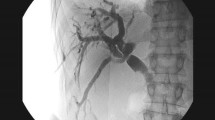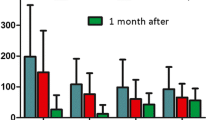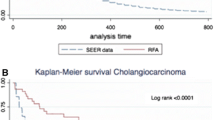Abstract
Background
Biliary radiofrequency ablation (RFA) using the Habib™ EndoHBP catheter is a new endoscopic palliation therapy for malignant biliary obstruction. The aim of this study was to assess the feasibility and safety of this technique.
Methods
In this nationwide retrospective study of prospectively collected clinical data, all patients treated by biliary RFA in Austria between November 2010 and December 2012 were included. Procedure-related complications, adverse events within 30 days post-intervention, stent patency, and mortality rates were investigated.
Results
A total of 58 patients (31 male, 27 female, median age 75 years) underwent 84 RFA procedures at 11 Austrian referral centers for biliary endoscopy. The predominant underlying condition was Klatskin tumor (45 of 58 cases). All 84 RFA procedures were feasible without technical problems. A partial liver infarction was induced by RFA in a 49-year-old Klatskin tumor patient. During 30 days after each RFA procedure, five cases of cholangitis, three cases of hemobilia, two cases of cholangiosepsis, and one case each of gallbladder empyema, hepatic coma, and newly diagnosed left bundle branch block occurred. Median stent patency after last electively performed RFA was 170 days (95 % CI 63–277) and was almost significantly different between metal and plastic stenting (218 vs. 115 days; p = 0.051). Median survival was 10.6 months (95 % CI 6.9–14.4) from the time of the first RFA in each patient and 17.9 months (95 % CI 10.3–25.6) from the time of initial diagnosis.
Conclusions
Except for one severe interventional complication (hepatic infarct), RFA presented as a technically feasible and safe therapeutic option for the palliative treatment of malignant biliary obstruction. The good results of stent patency and survival in this study should be proven in prospective (controlled) trials to further quantify the efficacy of this promising new technique.




Similar content being viewed by others
References
de Groen PC, Gores GJ, LaRusso NF et al (1999) Biliary tract cancers. N Engl J Med 341(18):1368–1378
Skipworth JR, Olde Damink SW, Imber C et al (2011) Review article: surgical, neo-adjuvant and adjuvant management strategies in biliary tract cancer. Aliment Pharmacol Ther 34(9):1063–1078
Smith AC, Dowsett JF, Russell RC et al (1994) Randomised trial of endoscopic stenting versus surgical bypass in malignant low bileduct obstruction. Lancet 344(8938):1655–1660
Kaassis M, Boyer J, Dumas R et al (2003) Plastic or metal stents for malignant stricture of the common bile duct? Results of a randomized prospective study. Gastrointest Endosc 57(2):178–182
Soderlund C, Linder S (2006) Covered metal versus plastic stents for malignant common bile duct stenosis: a prospective, randomized, controlled trial. Gastrointest Endosc 63(7):986–995
Hong W, Sun X, Zhu Q (2013) Endoscopic stenting for malignant hilar biliary obstruction: should it be metal or plastic and unilateral or bilateral? Eur J Gastroenterol Hepatol. doi:10.1097/MEG.0b013e328360b9ec
Ortner ME, Caca K, Berr F et al (2003) Successful photodynamic therapy for nonresectable cholangiocarcinoma: a randomized prospective study. Gastroenterology 125(5):1355–1363
Zoepf T, Jakobs R, Arnold JC (2005) Palliation of nonresectable bile duct cancer: improved survival after photodynamic therapy. Am J Gastroenterol 100(11):2426–2430
Ortner ME, Caca K, Berr F et al (2003) Successful photodynamic therapy for nonresectable cholangiocarcinoma: a randomized prospective study. Gastroenterology 125(5):1355–1363
Zoepf T, Jakobs R, Arnold JC (2005) Palliation of nonresectable bile duct cancer: improved survival after photodynamic therapy. Am J Gastroenterol 100(11):2426–2430
Itoi T, Isayama H, Sofuni A et al (2012) Evaluation of effects of a novel endoscopically applied radiofrequency ablation biliary catheter using an ex-vivo pig liver. J Hepatobiliary Pancreat Sci 19(5):543–547
Steel AW, Postgate AJ, Khorsandi S et al (2011) Endoscopically applied radiofrequency ablation appears to be safe in the treatment of malignant biliary obstruction. Gastrointest Endosc 73(1):149–153
Fu Y, Yang W, Wu JY (2011) Intrahepatic biliary injuries associated with radiofrequency ablation of hepatic malignancies. Chin Med J (Engl) 124(13):1957–1963
Cheng JL, Bruno MJ, Bergman JJ et al (2002) Endoscopic palliation of patients with biliary obstruction caused by nonresectable hilar cholangiocarcinoma: efficacy of self-expandable metallic Wallstents. Gastrointest Endosc 56(1):33–39
Knyrim K, Wagner HJ, Pausch J et al (1993) A prospective, randomized, controlled trial of metal stents for malignant obstruction of the common bile duct. Endoscopy 25(3):207–212
Dumoulin FL, Gerhardt T, Fuchs S et al (2003) Phase II study of photodynamic therapy and metal stent as palliative treatment for nonresectable hilar cholangiocarcinoma. Gastrointest Endosc 57(7):860–867
Kullman E, Frozanpor F, Söderlund C et al (2010) Covered versus uncovered self-expandable nitinol stents in the palliative treatment of malignant distal biliary obstruction: results from a randomized, multicenter study. Gastrointest Endosc 72(5):915–923
Acknowledgments
The authors would like to acknowledge the following people who substantially contributed to the data collection in the context of this study: Barbara Tribl, Patricia Kump, Wolfgang Vogel, Brigitte Hellmich, Antje Holzäpfel, Michael Wasilewski, Isolde Hinterberger, Franz Siebert, Andreas Maieron, Rainer Schöfl, Johann Pidlich, and Karl Dam.
Disclosures
Werner Dolak, Florian Schreiber, Hubert Schwaighofer, Michael Gschwantler, Wolfgang Plieschnegger, Alexander Ziachehabi, Andreas Mayer, Ludwig Kramer, Andreas Kopecky, Christiane Schrutka-Kölbl, Gernot Wolkersdörfer, Christian Madl, Frieder Berr, Michael Trauner and Andreas Püspök have no conflicts of interest or financial ties to disclose. This study did not receive any public funding or industrial sponsoring.
Author information
Authors and Affiliations
Consortia
Corresponding author
Additional information
This study is conducted for the Austrian Biliary RFA Study Group.
Electronic supplementary material
Below is the link to the electronic supplementary material.
Rights and permissions
About this article
Cite this article
Dolak, W., Schreiber, F., Schwaighofer, H. et al. Endoscopic radiofrequency ablation for malignant biliary obstruction: a nationwide retrospective study of 84 consecutive applications. Surg Endosc 28, 854–860 (2014). https://doi.org/10.1007/s00464-013-3232-9
Received:
Accepted:
Published:
Issue Date:
DOI: https://doi.org/10.1007/s00464-013-3232-9




